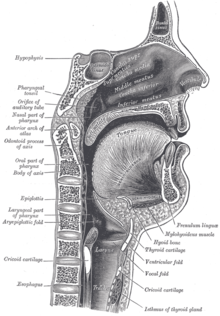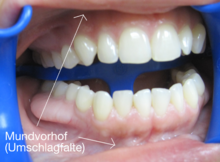Oral cavity
The oral cavity ( Latin Cavum oris ) is the space that is bounded by the lips at the front , by the hard and soft palate that separates it from the nasal cavity , at the sides by the cheeks and at the bottom by the floor of the mouth . The largest part of the oral cavity arises in the embryo from the oral cavity . In animals, the space is usually referred to as the mouth cavity , in birds as the beak cavity .
anatomy
To the rear, the oral cavity merges into the middle pharynx , which lies behind the two palatal arches . Between the anterior ( Arcus palatoglossus ) and the posterior palatal arch ( Arcus palatopharyngeus ) lies the palatine tonsil ( tonsilla palatina ), which together with the pharyngeal tonsils ( Tonsillae pharyngeales ) and the tongue tonsil ( Tonsilla lingualis ) form a ring-shaped group, the so-called Waldeyer's pharyngeal ring , named after the anatomist Heinrich Wilhelm Waldeyer . The front opening of the oral cavity is the oral cavity ( rima oris ), the back the throat or throat narrowing ( isthmus faucium ). The entire oral cavity is lined with a mucous membrane - the oral mucosa - that carries a multi-layered uncornified squamous epithelium .
The space between the lips / cheeks and the rows of teeth or, in the case of the edentulous, the protruding extensions of the jawbones ( alveolar processes ) is called the oral vestibule ( Latin vestibulum oris ). In the oral vestibule, the ducts of the open parotid glands ( parotid ) and the lip and cheek glands.
The space within the rows of teeth is called the actual oral cavity (lat. Cavum oris proprium ). It is largely filled by the tongue . In addition, here the ducts of the lead the sublingual glands and the submandibular gland .
Oral flora
The oral cavity is in communication with the outside world through the crack in the mouth and is therefore not sterile. Since it offers excellent living conditions for microorganisms due to its constant temperature, its high humidity and the presence of many niches, it is colonized by a large number of bacteria , yeasts and sometimes even protozoa , which are in ecological equilibrium with one another . This balance is important for oral health. If it is disturbed by external influences (e.g. poor oral hygiene , antibiotics ), diseases are often the result. For example, the intake of oral antibiotics can lead to a superinfection with yeasts (especially Candida albicans ). Many of the inflammatory diseases in the oral cavity (especially caries , gingivitis and periodontitis ) are not caused by newly introduced pathogens, but by a shift in the balance towards an overweight of certain types of bacteria that are always present in the oral cavity ("opportunistic infection").
Over 300 different types of bacteria have been found in the oral cavity, including about 600 different types of prokaryotes , including the archaea . The initial contamination with germs takes place in the birth canal during birth . After the first teeth have erupted, the acid-forming streptococci ( Streptococcus mutans ), which are partly responsible for the caries, are also observed.
function
The oral cavity serves several purposes. As the beginning of the digestive tract (head intestine), it is used for food intake, crushing and digestion (→ mouth digestion ). It breaks up multiple chains with the help of enzymes. In addition, the oral cavity is used for sound formation and thus language. The cheeks and their muscles that border them play an important role in facial expressions and thus communication.
Diseases
The most common diseases in the oral cavity include dental caries and inflammation of the gums ( gingivitis ), the tooth-supporting structures ( periodontitis , periodontal disease ) and the mucous membrane ( stomatitis ). This also includes inflammation of the tongue ( glossitis ) and other pathological changes in the tongue. Tumors (mostly squamous cell carcinoma ), cysts , leukoplakia and fungal infections ( mainly caused by Candida albicans , candidiasis ) are also less common in the oral cavity. The most common congenital diseases in the oral cavity ( malformations ) include misaligned teeth and clefts ( cleft lip and palate ).
But many general diseases also manifest themselves, often first, in the oral cavity (e.g. AIDS or autoimmune diseases such as Crohn's disease , pemphigus vulgaris or lupus erythematosus ). With the first manifestations, the oral cavity is of great importance in the early detection of these diseases, for example when visiting the dentist.
The diseases of the salivary glands are also related to the oral cavity .
literature
- Franz-Viktor Salomon: oral cavity, cavum oris . In: Salomon u. a. (Ed.): Anatomy for veterinary medicine . Enke-Verlag Stuttgart, 2nd ext. Edition 2008, pp. 239-264, ISBN 978-3-8304-1075-1 .
- J. Fanghänel (Ed.): Waldeyer Anatomie des Menschen . de Gruyter 2003, 17th edition. ISBN 3-11-016561-9 .
- Hans Adolf Kühn: diseases of the oral cavity. In: Ludwig Heilmeyer (ed.): Textbook of internal medicine. Springer-Verlag, Berlin / Göttingen / Heidelberg 1955; 2nd edition, ibid. 1961, pp. 747-751.
Individual evidence
- ↑ Human Oral Microbiome Database (accessed September 19, 2008).


